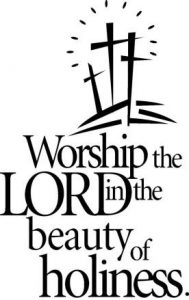
“Worship the Lord in the Beauty of Holiness”
Psalm 96:9
Oh, worship the Lord in the beauty of holiness!
Tremble before Him, all the earth. (NKJVTM)
Dear redeemed in Christ Jesus,
Week after week many of you have traveled here to Grace Lutheran Church in order to worship here. You have come here to sit in the pew and you participate in a worship service. In fact, 2015 is the 60th anniversary of our existence as Grace Lutheran Church. So for 60 years members have gathered here at Grace to do the very thing you are doing today.
Have you ever given much thought as to why there are certain things around you here while you worship? I am speaking of the basic things that have really been found in every church almost since the beginning of Christianity … things like the baptismal font, the altar, the lectern, the pulpit, and the pews where you are sitting. These things are important elements for our worship. So let’s consider each of them.
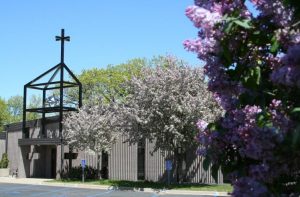
1. BUILDING
Matthew 18:20:
“For where two or three are gathered together in My name, I am there in the midst of them.”
Obviously for centuries Christians church buildings have taken on many different forms. The Bible doesn’t give us prescribed blueprint plans for how to construct a church structure. Certainly in the Old Testament God painstakingly gave all the details for the tabernacle. This was a temporary worship facility that was like a tent. It was moved from place to place as the children of Israel wandered about the wilderness for 40 years. Then King David planned the temple, the actual permanent structure in Jerusalem that was eventually built into God’s house of worship under the direction of King Solomon. This structure changed over the years as it was destroyed by the Babylonians, later rebuilt by those who returned from Babylon, and rebuilt again under King Herod.
Early Christians had a lot of freedom in how their houses of worship were designed. In fact, there were points in time in which early Christian had to worship in caves and other secret places where they could hide. They could not worship safely because Christianity was considered illegal at times. Home churches have always been typical throughout the centuries, even many of our CLC churches beginning in the humble dwelling of members’ homes. So there is a lot of freedom for us in having a house of worship. But Jesus once promised us that “wherever two or three are gathered together in My name, I am there in the midst of them.” That means that He is present as His word is proclaimed to us. And that’s what makes His worship something to respect. We are honoring Him when we come to worship Him. So this house of worship is to be a place of honor and dignity. As such, many churches are designed to give Him such respect. Some churches have high-pitched roofs to direct us heavenward. Some churches, like ours, have stained glass windows which share the Gospel message through art. They may aid us in our worship. But the presence of the Lord isn’t determined by them. The presence of the Lord is made possible by the proclamation of His Word. That is what makes this God’s house! He is present now. And as such we are to treat our worship location with dignity and respect. Moses was told to take off his sandals when he was in the presence of the Lord. We are to treat this sacred place with the same kind of dignity for the Lord is truly present now!
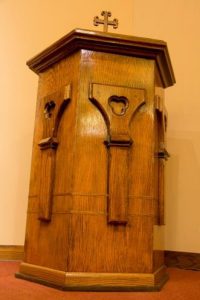
2. BAPTISMAL FONT
Acts 22:16:
“Arise and be baptized, and wash away your sins, calling on the name of the Lord.”
The baptismal font is usually located either at the entrance or at the front of the sanctuary. Intended to be the first thing you see, this is to be a reminder of your own baptism as you enter the church to worship. It can remind you of your entrance into God’s holy family, the Holy Christian Church. In the Middle Ages many churches had a special chapel or even a separate building for housing the baptismal font. This was called the baptistery. Our font at Grace happens to be located by the altar in front of the church. Its location, too, can serve as a reminder of our baptism.
The font is designed to hold water, the most common of all earthly elements. 2/3’s of the earth is covered with water. But what makes that water effective and powerful is the Word of God. It makes that baptism more than just a bath, a shower, or a simple washing of the hands. That water with the Word of God actually washes away sin! The passage says, “Arise and be baptized, and wash away your sins, calling on the name of the Lord.” Baptism also, as we are told in Scripture, makes one a child of God. For it tells us in Galatians 3:2627: “For you are all sons of God through faith in Christ Jesus. For as many of you as were baptized into Christ have put on Christ.”
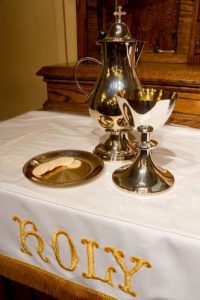
3. ALTAR (FOR SACRAMENT)
1 Corinthians 10:16:
The cup of blessing which we bless, is it not the communion of the blood of Christ? The bread which we break, is it not the communion of the body of Christ?
Baptism is not the only sacrament with power. The other is the Lord’s Supper. In the catechism it is commonly referred to as the Sacrament of the Altar. This is because this sacrament is often placed on the altar from which it is served. The wine and the bread are the earthly elements that are visibly there. They are what we see on the altar. But as our passage says, these are not alone. Christ’s body is present with the bread. Christ’s blood is present with the wine. This is why we at times also refer to this sacrament as Holy Communion. Communion means “the coming together into one.”
Christ’s body becomes one with the bread; and Christ’s blood becomes one with the wine. Certainly we eat the bread and drink the wine in a regular way like we normally would. But we are also partaking of Christ’s body and blood in a sacramental way, a miraculous way. It’s a miracle because Christ’s body and blood “are given and shed for the remission of sins.” This is what the words of institution say.
So the altar is a reminder of this sacrament. Some churches may even have a table specifically used for this purpose. The elements of the sacrament are placed on it. Martin Luther recommended a stand-behind altar. For this, the pastor stands behind the altar because as he is speaking the words of institution to the people, for they are the promises of God from His Word. He does not speak the words to the elements with some sort of magical spell. This is why I face the congregation as I speak the words of institution, merely pointing to the elements in reference. These words are for you to take and hold by faith.
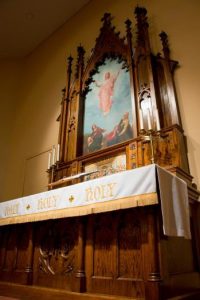
4. ALTAR (FOR WORSHIP)
Psalm 43:3-4:
Oh, send out Your light and Your truth! Let them lead me; Let them bring me to Your holy hill And to Your tabernacle. Then I will go to the altar of God, To God my exceeding joy; And on the harp I will praise You, O God, my God.
Again we focus on the altar, but now for our worship in general. The altar is the one common worship element that one observes in the Old Testament and with the Christian churches of the New Testament. Psalm 43 expresses that worship takes place at the altar of God. In the Old Testament times, God’s people would bring bulls and sheep to be sacrificed and then burned on the altar. These were offerings that the people brought before the Lord. By bringing these offerings to the altar, they expressed their thanksgiving to God, they expressed their praise to God, and they expressed their repentance to God. They looked to Him for remission of sin. So the altar, even for us, is where we express the same kinds of things. The altar is a reminder of the Lord’s blessing and presence upon us. As God’s people, you are facing the altar from the pews. From there you are expressing your thanksgiving to God, your praise to God, and also your repentance.
Jesus Himself was sacrificed on an altar. That altar was the cross. Many Christian altars therefore exhibit a cross because of this.
You may notice in our worship that there are times when the pastor is facing you and there are times when the pastor is facing the altar. This is because there is a sacrificial and a sacramental approach in our worship. Our sacrificial approach is when God’s people are speaking to God. This is when the pastor and congregation together are facing the altar. This approach is used during such things as our prayers, when we are confessing our sins together, or even when we bring an offering to the Lord. On the other hand, there are times in which the pastor is facing the congregation. We call this the sacramental approach to our worship. This is when the Lord is actually speaking to you. Therefore the pastor faces you when he announces the absolution of your sins, when he pronounces the fact that your sins are forgiven through what Christ has accomplished. This also includes the benediction at the end of the service, the blessing that the pastor speaks to you with raised arms. That’s the Lord speaking and laying His blessing upon you.
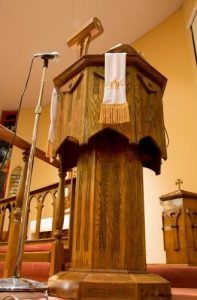
5. LECTERN
Luke 11:28
“Blessed are those who hear the word of God and keep it.”
These words were spoken by Jesus about the importance of listening to His holy Word. Listen to His Word, and one is simply blessed! He promises us that! So whenever the Word of God is being read, it is something we should pay attention to. There was a time when Jesus visited Mary and Martha, two close friends of His. Martha was busy in the kitchen preparing a meal. But Mary was sitting at the feet of Jesus, listening to the words that He was teaching her. After Martha expressed annoyance that Mary wasn’t helping her with the meal, Jesus reminded Martha that it was Mary who was doing the one thing needful … the important thing. And so we, too, need to listen attentively to God’s Word regularly, even in our worship.
From the lectern we hear the Scripture readings. These include such readings from the Psalms. These were Old Testament songs that God’s people used for worship. We also have the Old Testament Scripture readings, anything from Genesis all the way through Malachi which tell us about things that happened before Christ. And then, of course, we also have readings from the Gospels, the first four books of the New Testament: Matthew, Mark, Luke and John. These four Gospels tell us about the teachings, life, death, and resurrection of our Savior while He lived here on earth. We also have the readings from the Epistles. The word “epistle” is the Greek word for a written letter. These were letters written to different congregations or by certain individuals. These were mostly from the Apostle Paul, but also from people like John and Peter. The letters were intended to strengthen the doctrinal training or bring instructions to early Christians. They still apply to us, even today. All these readings from the Old and New Testaments are God’s words being spoken to us.
Our attitude is really to be that like that of the Old Testament prophet, Samuel, who, even as a young boy, had the attitude when God spoke to him: “Speak, Lord, for your servant hears.”
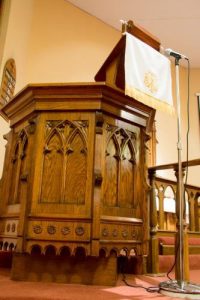
6. PULPIT
2 Timothy 4:2:
Preach the word! Be ready in season and out of season. Convince, rebuke, exhort, with all longsuffering and teaching.
The pulpit looks very much like the lectern. It is probably a little bigger than the other in most churches. Certainly God’s word is read from both of them. But from the pulpit we hear the Word of God that is truly in our focus for the day. During the week, the pastor prepares a sermon which he preaches from the pulpit. The sermon is really where he expounds upon God’s Word. It is a meditation for God’s people to reflect upon God’s teachings but also how it applies to each of us individually.
Understanding their importance, Jesus Himself preached sermons. Some of them are famous like the Sermon on the Mount or the Sermon in the Upper Room the evening before he died. He once preached on the shore of the Sea of Galilee and had to get out in a boat because of the crowds. This boat became his pulpit as He preached from there. He explained the Scriptures to two disciples as He walked on the road to Emmaus on His resurrection day. Some of His final sermons during His earthly life were actually spoken from the pulpit of the cross, words like “Father, forgive them, for they do not know what they are doing” and “It is finished.”
Perhaps there are some who think they can do without a sermon, or maybe think it’s alright to miss out on a sermon or two during the month, or maybe just read one’s Bible at home. That’s when we fail to remember the value of sermons. In fact, sometimes the words “sermon” or “preach” can have negative connotations by many in our day. Let me share with you an illustration of the value of sermons from Jesus Himself. He once read from the book of Isaiah in His home town of Nazareth. Reading this section of the Bible didn’t bother the people as He read it. This may be the way it is for many who read their Bibles at home. But as soon as Jesus began to preach and explain the Bible – and certainly He had a true exposition of it – then the people became disturbed because now they knew what it actually meant. You see, sermons challenge us! And that’s a good thing.
Sermons apply the Scriptures to each of our daily lives. A good sermon has the Law, pointing out our sins and telling us about the eternal punishment we deserve because of them. But then a good sermon also includes the comforting Gospel, reminding us of what Jesus did, out of His grace, to take care of our problem of sin. Each of us needs that constant challenge on a regular basis! We can’t get that by reading our Bibles at home. We need to be challenged in order to grow spiritually and in our relationship with our Lord. The pastor is trained to certainly study the Bible in its original languages, but he is also there to help us understand it better and to apply it to each of us. He’s there to challenge us! And that’s what we get from the pulpit.
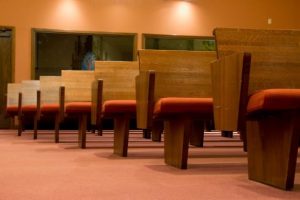
7. PEWS
Psalm 111:1:
Praise the Lord! I will praise the Lord with my whole heart, In the assembly of the upright and in the congregation.
We live in a very casual society today. Years ago the worship setting was actually quite formal, perhaps where some were almost were afraid to walk in the church. But our casual society can easily influence our approach to worship. Perhaps some might think it’s time to grab a cup of coffee, bring it into the church, and sip from it during the worship service. Or maybe you might make yourself comfortable into the pew like you would in a recliner. After all, a lot of our movie theaters now have recliners in them where one can put one’s feet up, relax, and watch a movie. This may be why so many do not understand worship. Worship is not entertainment. Worship is actually being engaged with your heart and with your mind with regard to what is going on. Jesus said, “God is Spirit, and those who worship Him must worship in spirit and truth” (John 4:24).
Worship is actually work! It is hard. It is a challenge to stay focused. We are gathered together, as even the Old Testament psalmist says, “In the assembly of the upright and in the congregation.” That’s here in the pews! We are to sing and fully participate in the worship service, fully engaged with our body, our heart, and our mind. We are absorbing the Lord’s Word during our worship and we are praising Him from our innermost being. That’s not something to treat casually.
Every year at the time of Lent we read the Passion account about how Peter, James, and John were with Jesus
as He prayed in the Garden of Gethsemane. And as He was there – sweating and fervently praying, experiencing all that suffering – Peter, James, and John were all sleeping. Whenever I read that section during the Lenten service, I have noticed that people seem a little more perky in the pews because they get the point. Our worship is not to be a sleepy event. But that’s what our sinful nature is prone to do. And do we too easily cave in to that? Do we treat our worship like it’s not that big of a deal? Do you stand reverently before the Lord when we stand up in our worship? We need to be aware that it is so easy for the devil and our own sinful flesh to distract us. When we are in the pews, we are assembled together to worship the Lord before His altar, to worship Him in spirit and in truth. Your presence and engagement from the pew is where it all starts. By being present here regularly at church, you help support your fellow Christians. But more importantly, you are present in the pews to worship the Lord. After all, our worship is only one hour out of our week; and yet the Lord’s with us every hour of the week as He blesses us, cares for us, and keeps us steadfast in His word. Certainly He deserves our time as well.
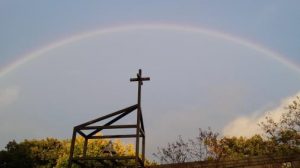 So think about the importance of each of the items in our worship:
So think about the importance of each of the items in our worship:
1) the building that we are in,
2) the baptismal font that’s before us,
3) the altar from where we receive the Lord’s Supper,
4) the altar to remind us of the Lord’s presence in our worship,
5) the lectern where we hear God’s Word read,
6) the pulpit where we hear God’s Word expounded to us, and
7) the pews from where we worship the Lord with our fellow Christians.
Each of these items are here to direct our hearts and minds to our Triune God – Father, Son, and Holy Spirit. All these things direct us to the Means of Grace, the Gospel in Word and Sacrament. That is what gives our worship beauty!
Psalm 96:9:
Oh, worship the Lord in the beauty of holiness! Tremble before Him, all the earth.
| 1. Built on the Rock the Church doth stand, Even when steeples are falling; Crumbled have spires in every land, Bells still are chiming and calling, Calling the young and old to rest, But above all the soul distrest, Longing for rest everlasting. |
5. Still we our earthly temples rear That we may herald His praises; They are the homes where He draws near And little children embraces. Beautiful things in them are said; God there with us His covenant made, Making us heirs of His kingdom. |
| 3. We are God’s house of living stones, Builded for His habitation; He through baptismal grace us owns Heirs of His wondrous salvation. Were we but two His name to tell, Yet He would deign with us to dwell, With all His grace and His favor. |
6. Here stands the font before our eyes Telling how God did receive us; Th’ altar recalls Christ’s sacrifice And what His table doth give us; Here sounds the Word that doth proclaim Christ yesterday, today, the same, Yea, and for aye our Redeemer. |
| 4. Now we may gather with our King E’en in the lowliest dwelling; Praises to Him we there may bring, His wondrous mercy forthtelling. Jesus His grace to us accords; Spirit and life are all His words; His truth doth hallow the temple. |
7. Grant then, O God, where’er men roam, That, when the church-bells are ringing, Many in saving faith may come Where Christ His message is bringing: “I know Mine own, Mine own know Me; Ye, not the world, My face shall see. My peace I leave with you.” Amen. (TLH 467) |
Submitted by Pastor John Hein
Pastor, Grace Lutheran Church
Soli Deo Gloria!
January 18, 2015